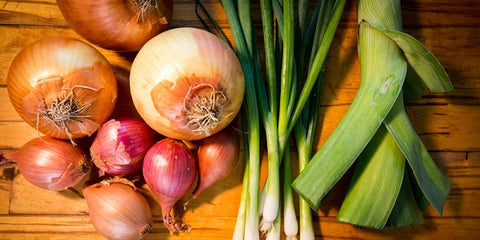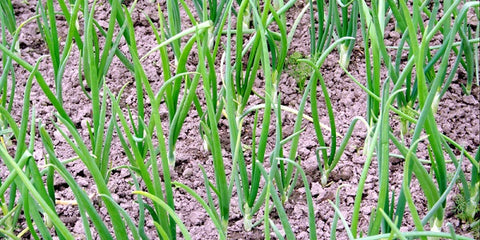Guide to Growing Onions

Onions, bulbing onions (including shallots) and leeks are all members of the Allium family and require similar growing conditions, so let's gather them together...
Alliums all require full sun and fertile well drained soil (with a pH of between 6.0 and 7.0) so sandy soils are ideal. In heavier soils, use raised beds or raised rows to promote better drainage.

Onion and leek seed germinates best at 20 -25 degrees C in 10-14 days. It will sprout at lower temperatures, down to 12-15 degrees, it just takes a bit longer. The seed can be sown directly into the ground where it's going to be grown, and later thinned to correct distances apart.
Alternatively, seedlings transplant easily - they can be started in trays and placed out at the right spacings when big enough. An advantage of transplants is that you can keep that part of your garden weed free a lot easier for an extra couple of weeks.
Allium seed doesn’t have a long shelf life compared to tomato or pumpkin seed, try and get what seed you need fresh each year to maintain vigour and viability.

For spring onions (Allium fistulosum), a final spacing of 5 cm apart is best, with bigger bulbing onions (Allium cepa) preferring 10-15 cm between plants to give them plenty of room to size up.
Leeks (Allium porrum) need a little more room to reach their full size, with a spacing of 20 cm being ideal. However, not thinning them till quite late gives you the luxury of the unwanted thinnings as baby leeks, a well regarded gourmet item. To achieve nice long white leeks, it's best to hill or mound the soil up round the plant 2 or 3 times during the growing season, this forces the leaves higher up the plant.

Spring onions will generally be mature enough after 65 days from sowing, bulbing onions and leek take twice as long depending on the weather, time of year and soil conditions. Onions and leeks are shallow rooted and grow best with regular rainfall or irrigation. Insects that can be a nuisance are thrips and aphids, and onions are susceptible to various sooty moulds. Good ventilation, a healthy garden and control of these problems at an early stage will keep the problems in check.
Onions that bulb up are influenced by day length and are classified into 3 groups Short, Intermediate and Long day types. Each group is suited to a different latitude and time of year they’re sown. Generally speaking, Intermediate Day Length onions suit being sown in spring and early summer in most parts of New Zealand.
Harvest onions when the necks become soft and tops are falling over, pull out of the ground and sun cure them on the surface for a few days to allow a skin to form before moving them inside to a well ventilated spot where they can dry further.

Suggested varieties from the range:
Spring Onions – Organic Tokyo Long White, Red Bunching, Ishikura and White Welsh
Cipollini – Pearl Drop, Borettana and Purplette
Large Sweet Summer Onions – Organic Walla Walla, White Sweet Spanish and Yellow Sweet Spanish
Long Keepers - Organic Red Amposta, Italian Long Keeper, Red Brunswick and Shallot Zebrune
Leeks - Organic Carentan Giant, Winter Giant and Lungo Della Riviera (grow the latter closely spaced for baby leeks)
NB: Garlic is also an allium but is grown from a clove, not a seed and generally placed out round the shortest day of the year and harvested round the longest day.
Featured by Twinkl in ''Top Tips For Starting a Kids-friendly Vegetable Garden.






















































